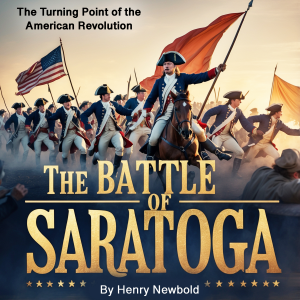

The Battle of Saratoga
Henry Newbold
This audiobook is narrated by a digital voice.
The Battle of Saratoga did not emerge in isolation but was the product of a steadily building storm between the American colonies and the British Crown. The roots of conflict stretched back over a decade before shots were fired. The British Parliament’s attempts to assert greater control over its American territories—through a series of taxes and legislative acts such as the Stamp Act, the Townshend Acts, and the Tea Act—fueled colonial resentment. Colonists argued these measures violated their rights as Englishmen, particularly the principle of “no taxation without representation.” This friction culminated in open rebellion with the outbreak of the Revolutionary War in 1775, following the battles at Lexington and Concord.
As the war unfolded, both sides recognized the importance of controlling the Hudson River Valley. This vital corridor offered a strategic advantage, linking New England to the other colonies and allowing movement of troops and supplies. The British believed that isolating New England—seen as the hotbed of rebellion—would cripple the colonial resistance. Thus, a plan was developed to cut the colonies in two by taking control of the Hudson. General John Burgoyne was tasked with leading an army south from Canada to meet up with British forces advancing north from New York City. A third force under Colonel Barry St. Leger would move in from the west. This three-pronged strategy, if executed properly, promised a swift end to the war.
However, the British plan was fraught with logistical challenges and lacked effective coordination. Communications between the three forces were poor, and the difficult terrain slowed movement considerably. Moreover, the American response to the British plan was swift and adaptive. The Continental Army, aided by local militias, worked to obstruct British movements by destroying roads, blocking supply lines, and harassing the enemy’s progress through guerrilla tactics.
Duration - 1h 48m.
Author - Henry Newbold.
Narrator - Digital Voice Maxwell G.
Published Date - Tuesday, 07 January 2025.
Copyright - © 2025 Henry Newbold ©.
Location:
United States
Description:
This audiobook is narrated by a digital voice. The Battle of Saratoga did not emerge in isolation but was the product of a steadily building storm between the American colonies and the British Crown. The roots of conflict stretched back over a decade before shots were fired. The British Parliament’s attempts to assert greater control over its American territories—through a series of taxes and legislative acts such as the Stamp Act, the Townshend Acts, and the Tea Act—fueled colonial resentment. Colonists argued these measures violated their rights as Englishmen, particularly the principle of “no taxation without representation.” This friction culminated in open rebellion with the outbreak of the Revolutionary War in 1775, following the battles at Lexington and Concord. As the war unfolded, both sides recognized the importance of controlling the Hudson River Valley. This vital corridor offered a strategic advantage, linking New England to the other colonies and allowing movement of troops and supplies. The British believed that isolating New England—seen as the hotbed of rebellion—would cripple the colonial resistance. Thus, a plan was developed to cut the colonies in two by taking control of the Hudson. General John Burgoyne was tasked with leading an army south from Canada to meet up with British forces advancing north from New York City. A third force under Colonel Barry St. Leger would move in from the west. This three-pronged strategy, if executed properly, promised a swift end to the war. However, the British plan was fraught with logistical challenges and lacked effective coordination. Communications between the three forces were poor, and the difficult terrain slowed movement considerably. Moreover, the American response to the British plan was swift and adaptive. The Continental Army, aided by local militias, worked to obstruct British movements by destroying roads, blocking supply lines, and harassing the enemy’s progress through guerrilla tactics. Duration - 1h 48m. Author - Henry Newbold. Narrator - Digital Voice Maxwell G. Published Date - Tuesday, 07 January 2025. Copyright - © 2025 Henry Newbold ©.
Language:
English
Chapter 1: Prelude to Conflict
Duration:00:11:45
Chapter 2: Commanders and Leadership
Duration:00:12:04
Chapter 3: The March South
Duration:00:12:26
Chapter 4: The First Battle of Saratoga – Freeman’s Farm
Duration:00:13:11
Chapter 5: The American Response
Duration:00:15:18
Chapter 6: The Second Battle of Saratoga – Bemis Heights
Duration:00:13:31
Chapter 7: The Surrender at Saratoga
Duration:00:13:16
Chapter 8: Global Impact of the Victory
Duration:00:14:02
Conclusion
Duration:00:02:52